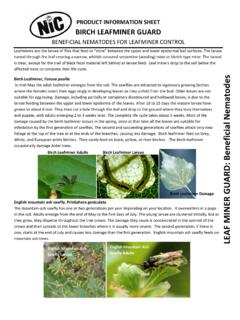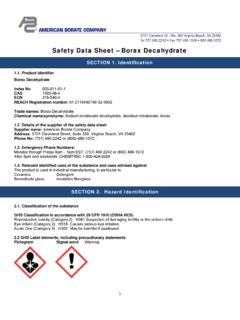Transcription of Hair Sheep - Tarleton State University
1 Hair SheepHair Sheep Excellent breed for hobby farmers looking for a low maintenance animal to control weed and brush growth in their pastures. They are good mothers Good milk producers Seldom require assistance lambing. Docile As with most Sheep and goats, Hair Sheep are mainly reared in the arid and semi arid areas Lifespan is 8-12 years sexually mature at 5-6 months. Gaining popularityHair SheepNo Shearing Necessary They shed their longer hair in the spring hence, do not require shearing Although some wool will be present, they are predominately covered in Hair Decreases the stress and injury of shearing Cost of shearing exceeds the value of the fleece. Either absorb the cost or don t shear loss of production in heatHair SheepParasite Resistance Most hair breeds have better resistance to parasites than wool breeds. Sheep Kedswhich typically which hide in wool are easier for a hair Sheep to rub off Parasites, like worms, also seem to occur less often in hair SheepNo Docking Necessary woolly tails collect feces get in the way of breeding, attract parasites and flies.
2 Hair Sheep have shorter hairs on their tail, thus their tails remain cleanHair SheepSmaller Frame Size Hair Sheep breeds are generally smaller than wool breeds easier to manage, and handle. Hair SheepTaste Great -Less Fat Most Hair Sheep lambs are raised for meat. Meat is leaner Better tasting Mild in flavor Marketable at an older age than the wool breeds (even past the "lamb" stage)Hair SheepDecreased Death Loss at lambing By using a hair Sheep ram in a cross breeding program on the larger wool breed ewes, a manager can reduce the number of problems ewes may experience when lambing. Smaller lambs mean fewer problemsHair SheepEnvironmentally Adaptable They are very adapt in hot or cold climates, of course in extremely cold places they do well with a shelter but it does not have to be heated. Wool Sheep (unless shorn) suffer in heat and majorHair Sheep breeds include: AfricanaAfricana Found in Colombia and Venezuela Usually brown, ranging in shade from tan to brown and cherry-red to dark red.
3 PolledBarbadoBarbado Originated in Texas The breed originated from Barbados Blackbellysheep which were crossed with Rambouilletand mouflon. Game Ranch trophy animal due to its large horns. Tan, tan with a pale or black belly or pied. The coat varies from short hair to coarse wool with a large amount of kempfibers. Males have horns, for which the breed was selected, and the females are polled. Barbados BlackbellyBarbados Blackbelly Originated and evolved on the island of Barbados Coat: Complete covering of medium to thick-hair (no wool) that sheds in the spring Color: All shades of brown, tan or yellow, all are highlighted with contrasting black underpartsBlack points on the nose, forehead, and inside of the ears. Rams have a neckpiece of thick hair which extends down the neck to the brisket, some may cover to the shoulder. Horns: Both sexes of the Barbados Blackbellyare polled. White PersianBlackhead PersianBlackhead Persian The Blackhead Persianis a fat-tailed breedof domestic sheepfrom Africa.
4 The breed is also a type of hair Sheep , They do not grow wooland tolerate heat better than wooledbreeds Raised primarily for meat. Both sexes are polled Rams weigh 150 lb and ewes 110 lb At birth, rams and ewes weigh about lbBlackhead Persian Many people may mistake this Sheep for a goat, because it does not grow wool. Developed in South Africafrom Somaliansheep and been successfully exported to very humid places like Brazil and the Caribbean. There is also a variety of a slightly different color called the Redhead Persian Blackhead Persian purebreds give birth occasionally to a Redhead Persian Because they do not have wool, the Blackhead Persian has been bred for meat and leather. In addition to storing fat in their tail, they can store fat in their dewlap If they were developed in Africa, then how did they get the Persian part of their name? Legend has it that, in 1868, a cargo ship carrying Sheep from the Persian Gulf got stranded in South Africaby a terrible storm.
5 The white South African farmers knew a good Sheep when they saw one and traded their Sheep for the Sheep on board the boat, which became the foundation stock of the breed. Historians say that this legend is nonsense, but the name has Persian Blackhead Persians get their name for a good reason -their entire heads and necks are black. This makes a startling contrast to their white bodies. Sometimes there may be matching black on the legs, but usually the legs are as white as the bodies. They tend to carry their heads high when they are not grazing. This stance has made some aficionados of the breed describe their expression as "regal". They have long, goat-like ears. the milk of Blackhead Persians contains fat. Blackhead Persians and Redhead Persians have been used to help bolster any native Sheep breeds in hot, humid countries. They are noted to being a very healthy breed and have the ability to put on fat in tough grazing conditions.
6 Brazilian SomaliBrazilian Somali The Brazilian Somali is a hair breed which originated from the Blackhead Persian crossed with local Sheep . The breed is white with a black head. Both sexes are polled and it is small framed. They are one of the fat tail breeds. The breed is reported to the lowest mortality rate from birth to weaning of the breeds in Brazil. DamaraDamara The name of the breed was derived from the specific region where the Sheep were originally encountered (then known as Gross Damaraland). Damarasheep can survive in a harsh environment and under poor nutritional conditions It has a fairly high resistance to most Sheep diseases and also good tolerance against internal parasites Wattles are sometimes found under the throat. The Sheep has a wide range of colors which are all equally acceptable and desirable. Pigmentation in the skin is essential and is the only prescription concerning color. KatahdinKatahdin Michael Piel, of Maine, USA, set about creating a breed of Sheep to use for land maintenance, to control vegetation growth around power lines.
7 In 1957 he imported three young African Hair Sheep , all of whom had been triplets but were not related to each other. Two were ewes, and one was a ram. From there he set about breeding them with each other and other select breeds including the Suffolk, Hampshire, and He selected the Sheep he kept for breeding based on "hair", fertility, meat type conformation, and flocking instinct. In the 1970's he named the new breed "Katahdin", after Mt. Katahdin, in Maine. A registry was established in 1986, under the name Katahdin Hair Sheep The hair coat of the Katahdin varies in length and texture among individuals and can be any color or color combination. The Katahdin can be used in crossbreeding crossed with wool Sheep , the first generation offspring will in most cases have wool fleeces with hair usually takes at least 3 generations, to obtain offspring with a shedding hair coat and other purebred characteristics. Red MasaiRed Masai Originated in East Africa Fat-tailed type of hair Sheep Used for meat production Red-brown, occasionally pied Males are horned or polled Females are usually polled Known for being resistant to internal parasitesMoradaNovaMoradaNova Comes from northeast Brazil and is probably of African origin.
8 Both sexes are polled The rams do not have a throat ruff Predominant color is red to cream, but white animals are also found Small with mature ewe weights of about 65 lbs Breed association in eyPelib ey Descended from the West African Dwarfand is found in Cuba, coastal areas of Mexico and other locales in the Caribbean. Hair color ranges from beige, brown, dark brown, red, white, black and roan with both solid and combination of colors found. Males do carry a throat ruff but usually do not have horns. Ewes are also usually polled. RaboLargoRaboLargo RaboLargo, meaning broad tail, are found in northeastern Brazil White, pied or white with a colored head Both sexes are horned Individuals within the breed vary between hair and carpet Found primarily in the countries of Mauritania, Mali, Niger and Chad Rams do not have a throat ruff or mane Mature ewes weigh over 75 lbs White, white and brown, or white and black with lop ears Males display a long twisting pattern to the horns and the females are usually polledSanta In sSanta In s Breed of American Hair Sheep found in Brazil Red, black and white and can be spotted orsolid Large bodies, are long-legged and have largependulous ears Polled Rams do not have a throat ruff.
9 Mature weights of the ewes = 100 lbs and ifwell fed, the rams can weigh as much as 225 lbs The Santa In scan serve as a terminal sirebreed in a crossbreeding system SomaliSomali The Somali is a hair Sheep which is reared primarily for meat production White with a black head. Both sexes are polled The Blackhead Persian, which was developed in South Africa, originated from the Somali CroixSt. Croix The Virgin Island White breed is found in the and British Virgin Islands in the Caribbean Most of these Sheep are white with some solid tan, brown, black or white with brown or black spots. Both sexes are polled Rams have a large throat ruff. Mature Virgin Island White ewes and rams weigh 75 and 100 lbs, respectively. Easy to handle, and are active and vigorous but show no tendency to be wild. St. Croix Generally more resistant to internal parasites than conventional Sheep St. Croix ewe's lambs show high fertility at 6-7 months of age The ewes can breed back after one month after lambing Ewes can produce two lamb crops per year.
10 Twenty-five Virgin Island White Sheep , 22 ewes and 3 rams, were selected in St. Croix and imported into the by Dr. W. C. Foote of Utah State University in 1975. There were no records available on the animals. The criteria for selection were white color, lack of wool and average or better body size and conformation. These Sheep were the basis of the present St. Croix breed in the The size of the ewes in the averages 119 pounds, while the rams average 163 African Used for both dairy and meat production Usually white with lop ears but pied individuals are also seen. Males are horned and the females Found in northern Nigeria, southern Niger, central Chad, northern Cameroon and western Sudan Meat breed with distinctive markings. The front half of the body is black or brown and the back half is white. Rams are horned and the ewes are usually African DwarfWest African Dwarf The West African Dwarf is the predominant breed of the humid tropics from southern west Africa through central Africa Generally black piebald on white.










